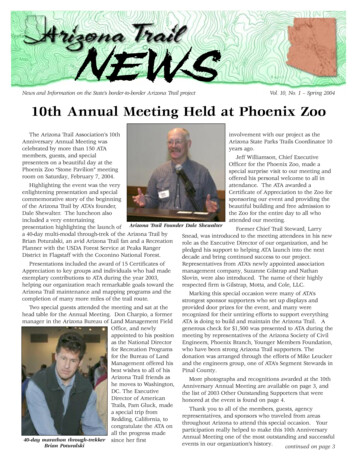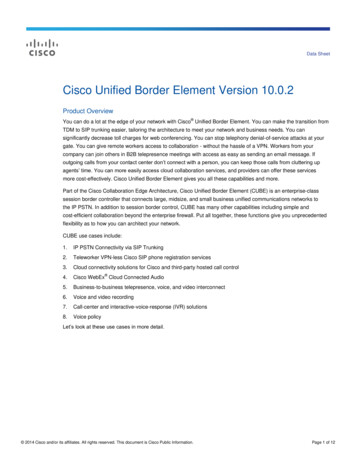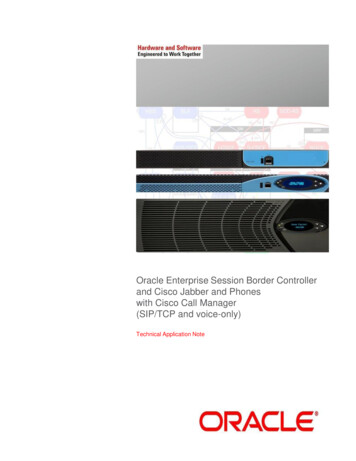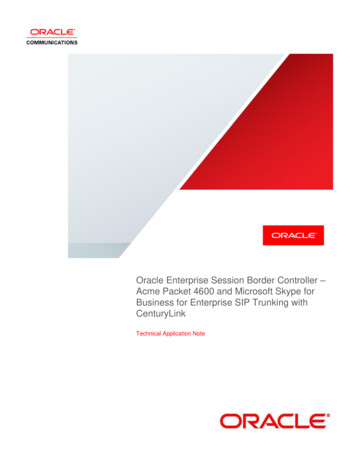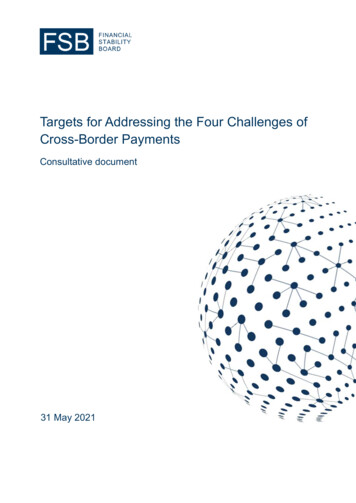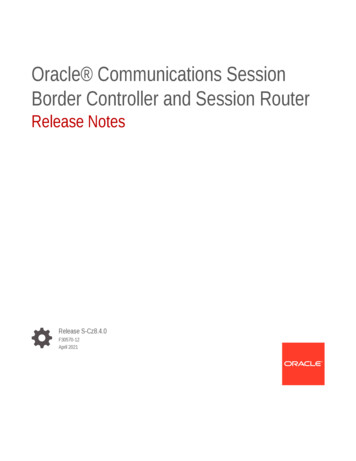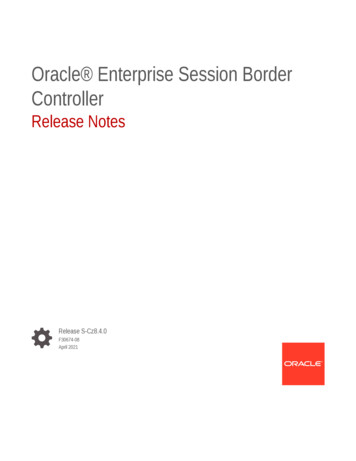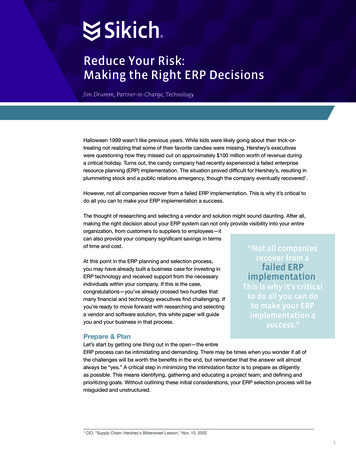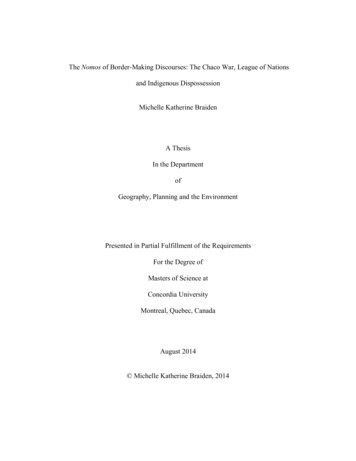
Transcription
The Nomos of Border-Making Discourses: The Chaco War, League of Nationsand Indigenous DispossessionMichelle Katherine BraidenA ThesisIn the DepartmentofGeography, Planning and the EnvironmentPresented in Partial Fulfillment of the RequirementsFor the Degree ofMasters of Science atConcordia UniversityMontreal, Quebec, CanadaAugust 2014 Michelle Katherine Braiden, 2014
CONCORDIA UNIVERSITYSchool of Graduate StudiesThis is to certify that the thesis preparedBy:Michelle Katherine BraidenEntitled:The Nomos of Border-Making Discourses: The Chaco War,League of Nations and Indigenous Dispossessionand submitted in partial fulfillment of the requirements for the degree ofMaster of Science (Geography, Planning and theEnvironment)complies with the regulations of the University and meets the accepted standardswith respect to originality and quality.Signed by the final Examining Committee:ChairPascale BironExaminerAlan NashExaminerKregg HetheringtonSupervisorKevin GouldApproved byChair of Department or Graduate Program Director2014Dean of Faculty
ABSTRACTThe Nomos of Border-Making Discourses: The Chaco War, League ofNations and Indigenous DispossessionMichelle Katherine BraidenConcordia UniversityThe Chaco War (1932-1935) was a border war fought between Boliviaand Paraguay over the Chaco Boreal, a vast expanse of land in the centre of SouthAmerica that was (and still is) traditional indigenous territory. This thesisanalyzes a document published by the League of Nations on the conflict, TheReport of the League of Nations Commission on the Chaco Dispute BetweenBolivia and Paraguay, from the perspective of critical border studies. TheLeague of Nations considered itself a disinterested third party arbitrator in thedispute. The central argument of this thesis is that the League was not adisinterested party and that its Report on the Chaco War is not a neutral retellingof the events of the Chaco War. Rather, the League’s Report is an expression ofdominant Western border-making practices and exemplifies the way in which theborder discourses of the interwar period failed to recognize indigenoussovereignty with respect to land, law and custom. This thesis therefore inquiresinto the relationship between borders and spatial imaginaries as embedded inthree discourses of indigenous dispossession: the doctrine of just war, the legalprinciple of uti possidetis de jure and the legal concept of terra nullius. The workof Carl Schmitt is used to highlight the links between these border-makingdiscourses and indigenous dispossession. Schmitt’s concept of the nomos isdiscussed in relation to the spatial order of the League of Nations and its attemptsto uphold the Westphalian paradigm of international law while simultaneouslyclaiming to be a humanitarian institution.iii
ACKNOWLEDGEMENTSI would like to thank Professor Kevin Gould for his patience, his support and hiscontinued dedication to this project. He has been incredibly helpful. Sincestarting this thesis, I have travelled to South America on four occasions, havelearned to conduct archival research, have become proficient in Spanish and(bizarrely) have transformed myself into a tango dancer. I hold Professor Gouldto be at least indirectly responsible for all of these things.I would also like to thank the examiners, Alan Nash and Kregg Hetherington, fortheir time and effort.iv
TABLE OF CONTENTSList of Maps viiiChapter 1: Introduction . 1Chapter 2: Context: The Gran Chaco, The League of Nations andIndigenous Dispossession . 10The Gran Chaco and the Chaco War .11The League of Nations and South American Intervention 14International Law and Indigenous Dispossession . 16Conclusion . 19Chapter 3: Literature Review: Boundary and Border Studies . 21Traditional Approaches to Border Studies . 22Critical “Postmodern” Geography and Boundary Discourses . 25Critical Border Studies: Traditional Borders Meets PostmodernBoundaries . 27Carl Schmitt and the Nomos of the Earth . 30Chapter 4: Theoretical Framework and Methodologies 34Theoretical Framework: Bordering Practices and BorderPerformances .34Methodologies: Discourse Analysis . 37Carl Schmitt and the Nomos as a Spatial-Ontological Device . 39Three Border Discourses: The Doctrine of Just War, Uti possidetisde jure and terra nullius . . 41The Discourses of the Doctrine of Just War . 42v
The Legal Principle of Uti possidetis de jure 44The Legal Concept of Terra nullius and EffectiveOccupation . 47Summary of Methodological Approach .49Chapter 5: Land Appropriation, Morality and the Doctrine of Just War . 51Jus ad bellum and the Origins of the Chaco Dispute . 52The Doctrine of Just War and Indigenous Dispossession . 55“Spatial Chaos”: Carl Schmitt and The League of Nations . 59Conclusion . 64Chapter 6: Land Division, International Law and Uti possidetis de jure . 66Uti possidetis de jure and the Chaco Dispute 66Uti possidetis de jure, the status quo and IndigenousDispossession . 71Carl Schmitt and the Nomos of the jus Publicum Europaeum . 75Conclusion . 78Chapter 7: Land Cultivation, Colonization and Terra nullius. 79The Colonization of the Chaco Boreal .79Terra nullius and Effective Occupation . 84Carl Schmitt, The League of Nations and Economic Imperialism 87Conclusion . 91Chapter 8: Conclusion . 93Bibliography . 95vi
LIST OF MAPS1. Map of Chaco War, 1932-1935. Baker Vail, 2009. Battle in the barrens.Military History Quarterly. Retrieved from bolivia-paraguay-1932-1935/ .12. Map of Chaco War, 1932-1935. Baker Vail, 2009. Battle in the barrens,Military History Quarterly. Retrieved from bolivia-paraguay-1932-1935/ .23. Map of Gran Chaco Plain. S. Romero, 2012. Vast tracts in Paraguay beingreplaced by ranches. New York Times. Retrieved .html?pagewanted all& r 0 .104. Proposed border line of Tratado Dicoud-Quijarro (1887). Rámon CésarBejarano, 1982. Síntesis de la guerra del Chaco. Serie Guerra del Chaco.Asunsion: Editorial Toledo. Retrieved fromhttp://www.portalguarani.com/845 ramon cesar bejarano/14373 sintesis de laguerra del chaco 1982 gral bgda sr ramon cesar bejarano .html . 555. Proposed border line of Tratado Avecel-Tamayo (1887). Rámon CésarBejarano, 1982. Síntesis de la guerra del Chaco. Serie Guerra del Chaco.Asunsion: Editorial Toledo. Retrieved fromhttp://www.portalguarani.com/845 ramon cesar bejarano/14373 sintesis de laguerra del chaco 1982 gral bgda sr ramon cesar bejarano .html . 566. Proposed border line of Tratado Benitez-Ichazo (1894). Rámon CésarBejarano, 1982. Síntesis de la guerra del Chaco. Serie Guerra del Chaco.Asunsion: Editorial Toledo.Retrieved fromhttp://www.portalguarani.com/845 ramon cesar bejarano/14373 sintesis de laguerra del chaco 1982 gral bgda sr ramon cesar bejarano .html . 577. Proposed border line of Tratado Soler-Pinilla (1907). Rámon César Bejarano,1982. Síntesis de la guerra del Chaco. Serie Guerra del Chaco. Asunsion:Editorial Toledo.Retrieved fromhttp://www.portalguarani.com/845 ramon cesar bejarano/14373 sintesis de laguerra del chaco 1982 gral bgda sr ramon cesar bejarano .html . 57vii
8. Borderlines of the Chaco War. Geografía iberoamerica, 2012. Retrieved roamericana 719. Mennonite Colonies of Paraguay. William Shroeder, 2004. MennoniteHistorical Atlas. Retrieved s/holdings/Schroeder maps/preface.htm . 83viii
Chapter One: IntroductionOn April 28th, 2009, President Fernando Lugo of Paraguay and PresidentEvo Morales of Bolivia met in Buenos Aires, Argentina to ratify the final reporton the demarcation of their shared international boundary. The final reportbrought to an end the long-standing boundary dispute that in the 1930s led to theChaco War (1932-1935), a devastating border war that was the first instance oftotal war in the Americas. The Chaco War is considered both the “first modernwar of South America” and the “last war of colonization of the free Indianterritories” as it involved the indiscriminate bombing of both soldiers and theindigenous inhabitants of the Gran Chaco (Krebs and Braunstein, 2011, p. 14).The war was fought by twosmall, poor, landlockedcountries, neither of which hadthe means of producing the armsneeded for modern warfare(Farcau, 1996). Paraguay hadthe backing of France andBolivia had the backing ofGermany. In the years beforeGuernica and the Spanish CivilWar, the air forces of theEuropean countries tried out theirMap 1: Map of Chaco War, 1932-1935. Baker Vail,2009new planes, weapons and strategies on what had been, until the 1930s, the tribalterritories of the Ayoreode, Yïshïro, Enxet, Angaité, Sanapaná, Guan’a, Enenlhit,Enlit, Yofuaza, Nievaclé, Mak’a, Toba-Gom and Guaicurúan peoples (HarderHorst, 2010).1
The Chaco War took place during the heyday of the League of Nationsand, despite the efforts of the League and the other American states to end theconflict, the war continued until the two sides were too exhausted to continue(Farcau, 1996). Over one hundred thousand soldiers died and the conflict also ledto epidemics, demographic decline, forced removals and massacres of theindigenous peoples of the region (Harder Horst, 2010). The soldiers on theParaguayan side were illiterate peasant Guarani mestizos and, on the Bolivianside, indigenous Altiplano Indians of Aymara and Quechan descent (Gotkowitiz,2007). The battles were fought across the terrain of the Gran Chaco, a vastexpanse of land that stretches from the foothills of the Andes to the Rio Paraguayand the edge of the Amazon Basin. In popular culture, the region was known asthe “green hell”—due to its harsh climate and extreme environment, it wasconsidered one of the most inhospitable places on earth (English, 2008).Both Paraguay andBolivia were members of theLeague of Nations. In 1932, asthe war was intensifying, theLeague convened aCommission of Reconciliationwhose members travelled to theSouth American continent withthe express purpose of bringingabout a settlement of the war.Paraguay and Bolivia were toturn the conflict over to theMap 2: Map of Chaco War, 1932-1935. Baker Vail,2009League—understood as “animpartial authority”—and haveit fix the frontier between the two countries (League of Nations, 1934, p. 138).2
The results of the League’s intervention can be found in their publication, TheReport of the League of Nations Commission on the Chaco Dispute BetweenBolivia and Paraguay, signed at Geneva on May 9th, 1934. The documentexamines the geography of the Chaco, the territorial claims of Paraguay andBolivia with respect to the international boundary and the evolution of the Chacoborder dispute from 1840 onward. It makes note of the near-constant wranglingon the part of Paraguay and Bolivia to establish ownership over the area anddetails the League’s efforts to come up with a program of arbitration for settlingthe dispute. The document also attempts to determine which side of the disputeought to be held responsible for the war and contains a survey of the militarysituation, likewise addressing the problem of armament.The purpose of this thesis is to consider the League of Nation’s Report onthe Chaco War from the perspective of critical border studies. Critical borderstudies inquires into the relationship between borders and spatial imaginaries byevaluating the ethical and political dimensions of the discourses that sustainborder regimes and control (Parker, Vaughan-Williams et al, 2009). It is anoffshoot of critical geography and moves away from the state-centric approachesof traditional border studies in order to make room for the concerns of non-state,sub-state and trans-state actors and agencies (Blake, 2000; Kolossov, 2006;Newman, 2006; Agnew and Muscarà, 2012). Critical border studies also movesbeyond descriptive, empirical-analytic approaches in order to incorporate theinsights of post-structural research, in particular those pertaining to discourseanalysis, deconstruction and critical theory (Grundy-Warr and Schofield, 2006).As with critical geography, critical border studies is predicated on the idea thatcritical forms of scholarship can be used to denaturalize, contest and alter thehegemony of dominant spatial representations (Blomely, 2006). As such, criticalborder studies views the border as a series of practices that are performed throughthe interactions that take place between state and non-state actors, processes and3
organizations. These practices and performances have the effect of sustaining ormodifying the border, be it through the activities that are more explicit, such aswar, or activities that are more subtle and passive, such as written documents.The League of Nations’ Report can therefore be considered a textualperformance of the Paraguayan-Bolivian border. The central argument of thisthesis is that the League’s Report does not provide a neutral retelling of the eventsof the Chaco War, but is instead reflective of the dominant geopoliticalimaginaries of the time. More specifically, the argument is that the League’sReport is an expression of dominant Western colonial border-making imaginariesand exemplifies the way in which the border discourses of the interwar periodfailed to recognize indigenous sovereignty with respect to land, law and custom(Graham and Weisner, 2011
principle of uti possidetis de jure and the legal concept of terra nullius. The work of Carl Schmitt is used to highlight the links between these border-making discourses and indigenous dispossession. Schmitt’s concept of the nomos is discussed in relation to the spatial order of the League of Nations and its attempts to uphold the Westphalian paradigm of international law while .
